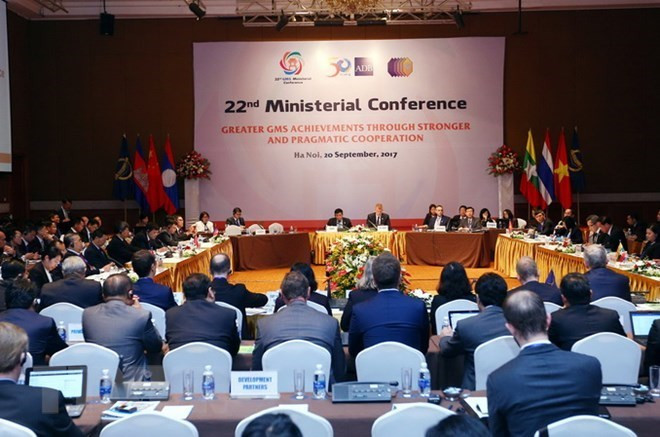 The 22nd Ministerial Conference on "Greater GMS achievements through stronger and pragmatic cooperation" hosted by Vietnam in September, 2017. (Photo: VNA)
The 22nd Ministerial Conference on "Greater GMS achievements through stronger and pragmatic cooperation" hosted by Vietnam in September, 2017. (Photo: VNA)Hanoi (VNA) – Vietnam has actively takenpart in developing initiatives for enhanced cooperation within the GreaterMekong Sub-region (GMS) to boost economic growth, strengthen economicconnectivity and aid poverty reduction effort in the region.
The GMS comprises of Cambodia, China (Yunnan andGuangxi provinces), Laos, Myanmar, Thailand and Vietnam. In 1992, the sixcountries entered into a programme of sub-regional economic cooperation,designed to enhance economic relations among the countries, as an initiative ofthe Asian Development Bank (ADB). Priority fields include infrastructuredevelopment, energy, telecommunications, tourism, trade-investment, humanresources, and the environment.
As of December 2017, about 6 billion USD has beenpoured into GMS cooperation projects in Vietnam, representing 30 percent of thetotal value of GMS loans and financial aids. Of the amount, transport accountedfor 87 percent, followed by urban development (7.9 percent), agriculture andnatural resources (3.7 percent), healthcare and social welfare (2.7 percent),industry and trade (0.4 percent), trade facilitation and transport (0.2percent).
Substantial progress has been made in terms of transportinfrastructure development since 1992 with the formation of vital economiccorridors to promote trans-border economic and social activities. Vietnam holdskey nodes in three GMS economic corridors – the Southern Coastal Corridor(GMS-SCC) which links Thailand to southern Vietnam via Cambodia, the East-WestEconomic Corridor (EWEC) that links Myanmar to Vietnam via central Thailand andLaos, and the North-South Economic Corridor (NSEC) with sub-veins linking Chinaand Vietnam. The corridors will help Vietnam reap most benefits from improvedtransport connectivity and growing trade and investment in areas along them.
Many ABD-funded road projects have been completed andput into use, including HCM City-Moc Bai and Dong Ha-Lao Bao routes operationalin 2005; and 244km Hanoi-Lao Cai Expressway, the longest of its kind inVietnam, in 2014.
Vietnam signed the GMS Cross-Border TransportFacilitation Agreement (CBTA) in 1999 and has ratified all CBTA’s annexes,enabling the reduction of amount of time spent in crossing border for vehicles,goods and passengers and facilitating trade. Since 2012, Vietnam and China havefacilitated each other’s vehicles crossing shared borders on the Kunming –Hanoi – Hai Phong and Hanoi – Nanning – Shenzhen routes. The same year,Vietnam, Thailand and Laos signed a Memorandum of Understanding to expand roadsconnecting capital cities of the three countries with two large sea ports –Laem Chabang (Thailand) and Hai Phong (Vietnam) on the EWEC.
In terms of energy, Vietnam has taken part in theRegional Indicative Master Plan on Power Interconnection in the GMS, paving theway for the country to bolster electricity trading and push for theestablishment of institutions to ensure power security within the region. Byattending meetings of the GMS Regional Power Trade Coordination, Vietnam hasgot updates on the GMS countries’ markets and energy-related plans and greatlybenefited from ADB’s technical support.
The country has played an active role in the GMS’strade and investment promotion events and enhancing regional partnership inagriculture, tourism, and telecommunications. It has also contributed to theGMS’s effort in controlling cross-border infectious diseases, such as SARS,bird flu, HIV/AIDS, malaria, and tuberculosis which are priorities of theregional cooperation in healthcare.
This year, Vietnam will host the sixth GMS Summit(GMS-6) in Hanoi from March 29-31. Themed “Leveraging 25 years of cooperation,Building an integrated, sustainable and prosperous GMS”, the GMS-6 is expectedto draw about 2,000 delegates and 150 reporters.
It aims to celebrate the 25th founding anniversary of the GMS Programme anddefine cooperation orientations to build a region of prosperity, integrationand sustainable development.
For the first time, a business forum will be held within the framework of theGMS-6 as an initiative of host Vietnam, with a view to increasing dialoguesbetween States and businesses and forging links between regional and globalenterprises.-VNA




























